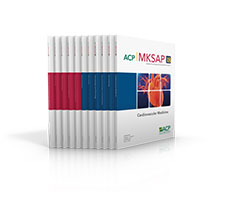Update your Knowledge with MKSAP 18 Q&A
 MKSAP has been trusted by internists since 1967 as the best resource for updating knowledge. MKSAP 18, available in Complete, Digital, and Print packages, consists of 11 comprehensive text chapters with related multiple-choice questions. You'll find 1,200 completely new questions to help you identify learning gaps, stay current, and gain the knowledge you need to provide the best possible patient care. MKSAP 18's original and high-quality questions evolve out of case studies and patient scenarios based on the latest evidence.
MKSAP has been trusted by internists since 1967 as the best resource for updating knowledge. MKSAP 18, available in Complete, Digital, and Print packages, consists of 11 comprehensive text chapters with related multiple-choice questions. You'll find 1,200 completely new questions to help you identify learning gaps, stay current, and gain the knowledge you need to provide the best possible patient care. MKSAP 18's original and high-quality questions evolve out of case studies and patient scenarios based on the latest evidence.
For more information on MKSAP 18, or to order your copy, visit mksap18.acponline.org.
MKSAP 18 Q & A
A 25-year-old woman is evaluated for a 1-month history of intermittent, loose, bloody bowel movements associated with pain in the left lower quadrant before defecation. The bleeding occurs with and without bowel movements. She reports no fever, chills, night sweats, arthralgia, eye pain, or rash. The patient works in a day care center and has not traveled or used antibiotics recently. She takes no medication.
On physical examination, vital signs are normal. The abdomen is scaphoid and soft, with suprapubic tenderness. The remainder of the physical examination is normal.
Stool testing for bacterial enteropathogens, including Clostridium difficile, is negative.
Colonoscopy results show patchy erythema and ulceration in the cecum, ascending colon, descending colon, and sigmoid colon with no involvement of the transverse colon or rectum. Mucosal biopsies of the involved mucosa reveal distorted and branching colonic crypts with lymphocytic and neutrophilic infiltration. Ileal examination is normal.
Which of the following is the most likely diagnosis?
A: Crohn disease
B: Giardiasis
C: Microscopic colitis
D: Ulcerative colitis

